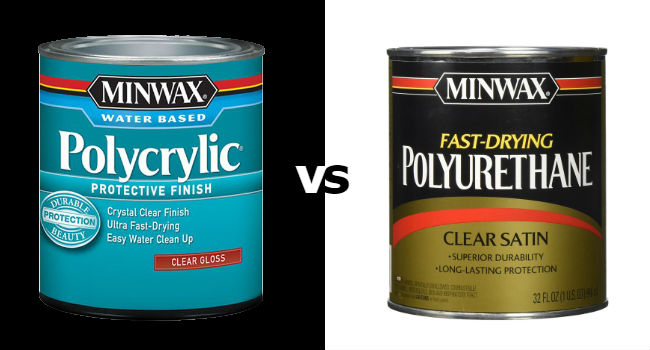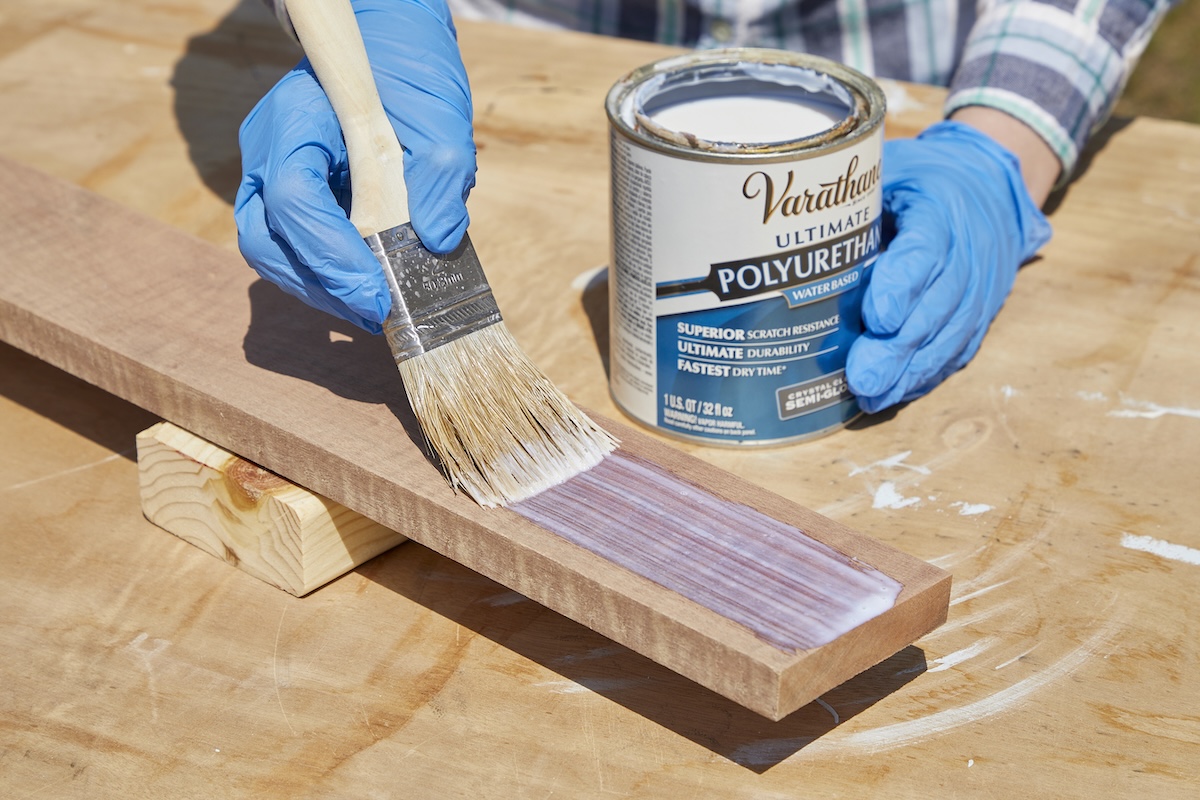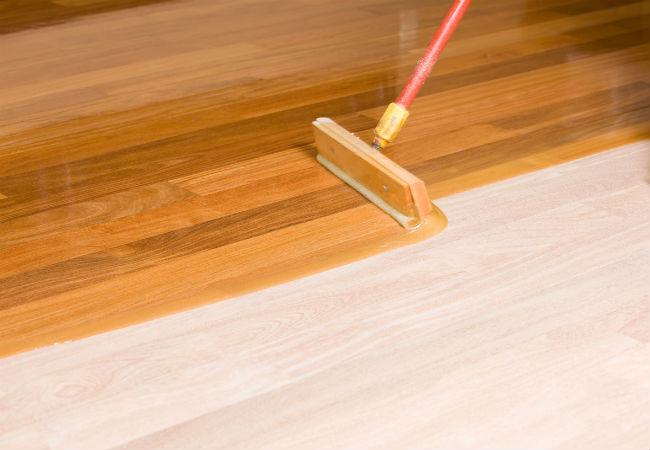

We may earn revenue from the products available on this page and participate in affiliate programs. Learn More ›
Wood sealers primarily protect wood from UV radiation, moisture, and mildew, keeping your wood furniture, deck, and woodworking projects safe from damage. Polycrylic wood sealer is a water-based product that dries quickly and has a low level of toxicity, while polyurethane wood sealer can come in either water- or oil-based products and tends to be more durable and last longer than polycrylic.
Choosing polyurethane vs polycrylic is an important step in finishing any woodworking project or sealing wooden furniture, especially if the wood will be exposed to rain, snow, UV radiation, and extreme temperature changes. When planning or beginning a woodworking project, weigh the information below to help determine which wood sealer is better for your job: polycrylic or polyurethane.
What is polycrylic?
It’s common for DIYers to ask if polycrylic is the same as polyurethane, especially given that both products are used for similar purposes. Despite this, the sealers are different in several key ways. In general, polycrylic is a water-based sealer typically applied to indoor wood surfaces due to its quick drying composition, low volatile organic compounds (VOCs), and non-yellowing finish. It’s made by blending water with a clear acrylic/urethane resin that creates a protective finish you can apply over wood stains or other finishes.
What is polyurethane?

Similar in use, but different from polycrylic, a polyurethane wood sealer can be either a water-based or oil-based formula. This protective wood finish helps to enhance the look and durability of wood surfaces, where oil-based and water-based polyurethane helps protect floors, furniture, and cabinets. However, polyurethane sealer has a higher level of VOCs, so it is better suited for outdoor projects or jobs completed in well-ventilated areas.
Differences Between Polycrylic and Polyurethane
Though both sealers share a similar purpose, differ in composition, toxicity, drying time, durability, ease of application, and cost.
Composition
Polycrylic sealers are strictly water-based products, but there are both water-based and oil-based varieties of polyurethane from which to choose.
- Oil-based polyurethane is durable and scratch-resistant, important qualities when refinishing wooden floors or furniture that gets a lot of use (like a kitchen table).
- Water-based polyurethane finishes for wood dry faster. However, it’s not as resistant to high temperatures or water, and it’s more susceptible to scratches than oil-based polyurethane.
- Polycrylic is a water-based product that is less toxic than either type of polyurethane, which makes it easier to work with. It dries very quickly, but can take a long time to fully cure. Unfortunately, polycrylic is not as scratch-resistant as oil-based polyurethane, so resting anything on a surface covered with polycrylic that has not fully cured can scratch or indent the clear coat.
| Polycrylic | Polyurethane | |
| Easier to apply | ✔ | |
| Less toxic | ✔ | |
| Dries quickly | ✔ | |
| More durable | ✔ | |
| Lasts longer | ✔ |
Appearance
Both polyurethane and polycrylic come in satin, gloss, and high-gloss sheens, so you can go as shiny as you’d like to emphasize your wood’s character and craftsmanship. Questions about the aesthetics of these tints include whether polycrylic and polyurethane turn yellow over time, or dry clear.
- Oil-based polyurethane tends to dry with a slight yellowish tint. Use it only over wood that’s dark enough or warm enough to hide the yellow cast.
- Water-based polyurethane is the non-yellowing polyurethane. It dries completely clear, so you can use it over light woods like maple without worrying about tinging the wood yellow.
- Polycrylic is generally said to dry clear, too, as long as you apply it carefully. It can take on a milky appearance if it’s applied heavily over dark wood or paint.
Durability
You’re sure to get a durable, hard finish that will protect your wood furniture or floor from mild-to-moderate abuse regardless of which sealer you choose. But if you really need a sealer that can handle stronger stuff, such as daily, vigorous use or lots of foot traffic, oil-based polyurethane is your best bet. And if your finished piece will be exposed to high temperatures or moisture on a regular basis, oil-based polyurethane is definitely superior.
Oil-based polyurethane creates a highly durable finish that holds up well against physical abrasion, scratches, dent, chips, and nicks. Water-based polyurethane is not quite as durable as the oil-based product, though it’s still more durable than polycrylic, which can be prone to dents and scratching, making it more difficult to maintain.
Application
You’ll be presented with several application options at most hardware stores, but is it better to roll or brush polycrylic and polyurethane? Stick to a spray or brush for sealers and avoid rollers and foam brushes when applying these finishes. Polycrylic’s runny consistency requires thin coats and keeping an eye out for drips. Wait the recommended dry time to prevent a sticky finish.
If you’re wondering whether you can put polycrylic over polyurethane or apply polyurethane over polycrylic, the answer to both questions is yes. While both polyurethane and polycrylic can cover water-based or oil-based paints and finishes (including chalk paint), polycrylic typically doesn’t dry as quickly over matte latex paint due to additives in the paint.
Safety
One of the primary answers to the question of whether polycrylic is the same as polyurethane involves the difference in the level of toxicity and safety. While polyurethane is one of the best outdoor wood sealers, it’s very flammable while it’s wet, and should be stored carefully to prevent a fire. It also has a high VOC count that can irritate the lungs, while the fumes from polycrylic sealer are not nearly as toxic and odiferous as those that emanate from polyurethane. Regardless, always wear personal protective equipment, including a respiratory mask, while applying either substance.
Cost
The difference in cost between these two sealers depends heavily on whether you are using a water-based or an oil-based polyurethane product. Both polycrylic and water-based polyurethane tend to cost between $20 and $30 per quart, while oil-based polyurethane runs between $20 and $50 per quart. So, if cost is a significant factor in your final decision, then opting for either polycrylic or water-based polyurethane is the better option.
Maintenance
Polycrylic and water-based polyurethane only require soap and warm water to clean up after application, while oil-based polyurethane requires mineral spirits or even paint thinner to clean tools and drips or spills while you work. The durable finish of oil-based polyurethane is easier to maintain once applied to surfaces, however.
Longevity
Polyurethane generally will last longer than polycrylic before needing to be reapplied. However, polycrylic-sealed items remain in a safe place where they experience little damage, then both polyurethane and polycrylic can last for up to 3 years before you need to reapply or retouch the finish. So, ultimately the frequency with which you should reapply a sealant comes down to how well you care for your sealed items and their exposure to elements.
When to Use Polycrylic vs. Polyurethane

Both polycrylic and polyurethane work for the same types of projects, including desks, side tables, picture frames, and dressers. If you’ve weighed the pros and cons of each and still aren’t sure which product is best for your project, consider these best uses for each:
When to Use Polycrylic
- If you need a product with a fast dry time, polycrylic is the best choice.
- Use polycrylic if you are working indoors. It is less toxic than polyurethane, especially when working in a poorly ventilated area.
- Polycrylic is generally less expensive than polyurethane. If budget is a concern, go with polycrylic.
- Polycrylic is best if an easy cleanup is your top priority. You need only soap and water to remove it from your hands, paint brushes, and other surfaces where it might spill during application.
When to Use Polyurethane
- If the wood will be exposed to high temperatures or moisture, oil-based polyurethane is the best bet.
- Use water-based polyurethane when applying sealer to a light wood, or a wood that’s painted white or a light color.
- Oil-based polyurethane provides the most durable finish in high-use situations like flooring.
- The slower drying times of polyurethane can be beneficial when sealing a large piece of furniture, like a dining or kitchen table, to get a smooth finish over an expansive area.
- Polyurethane is easier to work with on an upright or vertical surface because it’s thicker than polycrylic and is less prone to dripping.
